Ever hear the phrase, ” it’s all fun and games until someone loses an eye”? It comes from ancient Rome, where anything was allowed in wrestling except for eye-gouging. Nowadays, parents often say it to their children to discourage them from dangerous activities. (Like it ever worked on me!) It is also importance to remember in the studio when you are working with power tools and torches. Safe practices are non-negotiable in the studio because it’s a lot harder to make beautiful jewellery when you’re missing an eye or a finger or both.
Clothing and Hair:
This is not the place to wear your evening gown with the long flowing sleeves or your Manolo Blanhik sandals. Sleeves should be close-fitted and short enough that there is no danger of them getting caught in any tools or being set on fire, and it’s best to wear cotton. Scarves and long necklaces or pendants are not a good idea either. ( Remember Isadora Duncan?) Closed toe shoes are a must because it’ll hurt if you drop something on your foot. When I’m in the studio, my standard uniform is a short-sleeved t-shirt, jeans and my comfiest closed-toe shoes. Dressed like this, it’s easier for me to focus on the jewellery that I’m working on, instead of fussing with my clothing. I’m comfortable and protected. Long hair must be tied back and bangs clipped back out of your face or you run the risk of loosing a patch of hair if caught in the flex shaft – very unpleasant experience!
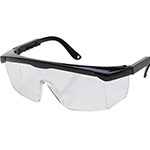 This is crucial in the studio. When you are working with power tools, it’s easy for a small piece of metal to go flying into your eye and cause a lot of damage. ( See phrase above ) Wearing safety goggles is the best way of preventing this. They can also be worn over reading glasses if you need to or you can get clip on magnifiers for your goggles. You can also buy a headband style magnifier, but you still need safety goggles as well – you can wear them together.
This is crucial in the studio. When you are working with power tools, it’s easy for a small piece of metal to go flying into your eye and cause a lot of damage. ( See phrase above ) Wearing safety goggles is the best way of preventing this. They can also be worn over reading glasses if you need to or you can get clip on magnifiers for your goggles. You can also buy a headband style magnifier, but you still need safety goggles as well – you can wear them together.
Food and Beverages:
You should never have food or open beverage containers in the studio because of the possibility of spillage. This is a distraction for you and it’s very important to keep your eyes on what you’re doing. It only takes a second of inattention for an accident to happen, so put your wine in a non-spill container! Seriously though, working while under the influence of any substance is a no-no. You need to be fully alert and present when using power tools or torches, otherwise the results can be disastrous.
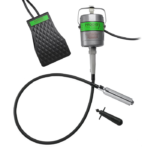
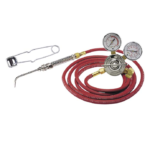 Always make sure that you know how to properly use all the tools. If you’re not sure how to use a tool safely, or are just not comfortable yet with the tool – ask for assistance! This is especially true for the power tools and the torches. You will not look foolish because you asked the question, but you will if you get hurt! You can also damage a tool if you don’t use it correctly, making it work poorly or at the worst, rendering it unusable. This can get very expensive depending on the tool. It’s also important to take care of your tools so that they produce the best results for you. Clean your files, maintain your flex shaft, bench polisher, and torch, so they work for you well and for a long long time. Also store your tools so they don’t get damaged. Damaged tools are frustrating and expensive to replace.
Always make sure that you know how to properly use all the tools. If you’re not sure how to use a tool safely, or are just not comfortable yet with the tool – ask for assistance! This is especially true for the power tools and the torches. You will not look foolish because you asked the question, but you will if you get hurt! You can also damage a tool if you don’t use it correctly, making it work poorly or at the worst, rendering it unusable. This can get very expensive depending on the tool. It’s also important to take care of your tools so that they produce the best results for you. Clean your files, maintain your flex shaft, bench polisher, and torch, so they work for you well and for a long long time. Also store your tools so they don’t get damaged. Damaged tools are frustrating and expensive to replace.
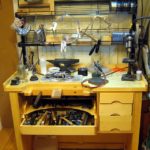 Your working environment is very important. For example, good lighting is the difference between sawing a lovely shape out of silver sheet or sawing a not so lovely shape out of your finger. Make sure you can see clearly, whatever you’re doing. Have your chair in the correct position at your bench, which is quite low. You should sit up straight, (remember what your mother said!) so that the chair supports your back, not leaning forward. The bench pin should be right across from you, at a little bit below shoulder level. There are also armrests that pull out on the bench which can help prevent fatigue and soreness in your upper body. If you are standing, your arms should be as close as possible to a ninety degree angle when they are on the bench. All of these things help to prevent fatigue, which can lead to mistakes and injury. Don’t forget to get up and move around once in a while. The human body is not made to stay in one position for long periods of time. And while you’re at it, use the 20/20/20 rule. Every twenty minutes, look at something twenty feet away for twenty seconds. This helps to prevent eye strain. Another important practice is to keep your studio clean. Spilled chemicals are a hazard, whether you slip on them or get them on your skin. Most of the chemicals we use in the studio are quite mild, but it is not recommended that you put your hands in them or breathe them in. Which leads me to the next subject – Ventilation.
Your working environment is very important. For example, good lighting is the difference between sawing a lovely shape out of silver sheet or sawing a not so lovely shape out of your finger. Make sure you can see clearly, whatever you’re doing. Have your chair in the correct position at your bench, which is quite low. You should sit up straight, (remember what your mother said!) so that the chair supports your back, not leaning forward. The bench pin should be right across from you, at a little bit below shoulder level. There are also armrests that pull out on the bench which can help prevent fatigue and soreness in your upper body. If you are standing, your arms should be as close as possible to a ninety degree angle when they are on the bench. All of these things help to prevent fatigue, which can lead to mistakes and injury. Don’t forget to get up and move around once in a while. The human body is not made to stay in one position for long periods of time. And while you’re at it, use the 20/20/20 rule. Every twenty minutes, look at something twenty feet away for twenty seconds. This helps to prevent eye strain. Another important practice is to keep your studio clean. Spilled chemicals are a hazard, whether you slip on them or get them on your skin. Most of the chemicals we use in the studio are quite mild, but it is not recommended that you put your hands in them or breathe them in. Which leads me to the next subject – Ventilation.
Ventilation:
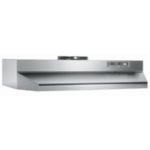 You are working with substances that emit noxious fumes, that need to be directed away from where you are working. Install a proper venting system, or on nice days, work outside if you can.
You are working with substances that emit noxious fumes, that need to be directed away from where you are working. Install a proper venting system, or on nice days, work outside if you can.
Fire Extinguisher:
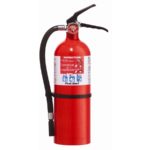 Keep a fire extinguisher at the DOOR to your studio. If a fire starts, you will automatically move away from it, so if the extinguisher is under your soldering bench, you won’t be able to get to it to extinguish the fire.
Keep a fire extinguisher at the DOOR to your studio. If a fire starts, you will automatically move away from it, so if the extinguisher is under your soldering bench, you won’t be able to get to it to extinguish the fire.
First Aid Kit:
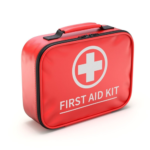 A first aid kit is a must. It should be stocked with bandaids, gauze, tape and hydrogen peroxide. You need to have an eyewash kit in case a something gets in your eye. Please remember not to rub your eye if you do get an irritant in it as this will make it more irritated or cause more damage. Another item for your first aid kit is lavender essential oil. If you get a burn, put it under cold running water for a few minutes and then apply one or two drops of lavender oil. It is anti-bacterial and will help speed healing and reduce scarring. If the injury really hurts, stop what you’re doing and take a break. Pain makes it difficult to focus, which can lead to more injury so take the time to take care of yourself.
A first aid kit is a must. It should be stocked with bandaids, gauze, tape and hydrogen peroxide. You need to have an eyewash kit in case a something gets in your eye. Please remember not to rub your eye if you do get an irritant in it as this will make it more irritated or cause more damage. Another item for your first aid kit is lavender essential oil. If you get a burn, put it under cold running water for a few minutes and then apply one or two drops of lavender oil. It is anti-bacterial and will help speed healing and reduce scarring. If the injury really hurts, stop what you’re doing and take a break. Pain makes it difficult to focus, which can lead to more injury so take the time to take care of yourself.
Above all, use your common sense when in the studio. If it seems like something may be dangerous, you probably shouldn’t do it. Follow the guidelines above and you will be a happy and healthy artisan jeweller!
